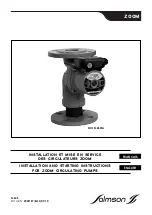
piping system and the end of the pipe sealed with a
female cap. If the testing is to be undertaken at a test
pressure less than
1
/
2
psi (3.5 kPa), the gas supply
manual shut-off valve must be closed. All testing must
be done according to CAN/CGA B149 in Canada and/or
the National Fuel Gas Code, ANSI Z223.1 in the United
States and local codes.
U.L. and CSA recognized fuel gas and Carbon
Monoxide (Co) detectors are recommended in all
applications and should be installed using the manu-
facturer’s instructions and local codes, rules or regu-
lations.
Installation Instructions for Water Heaters
Approved for Space Heating and
Potable Water Heating
(see Figure 11)
When using a water heater for space and pota-
ble water heating, the instructions provided in this
manual and with the air-handling unit must be respect-
ed and, in particular, the following:
1) All piping and components that are used in the
system must be of a nonferrous type suitable for
potable water. This also applies to any sealant
used.
2) When used as a dual purpose water heater, it must
not be connected to any system that has been
previously used for non-potable water heating. This
includes any piping because, in all probability, exist-
ing piping would have been, in the past, treated
with chemicals for cleaning or sealing the system.
3) If this water heater is to be used for space heating,
make sure that all safety codes are respected.
Pay special attention to safety valve pressure and
expansion tanks.
4) Do not use toxic chemicals to clean the potable
water heating system.
5) Where water temperature in excess of 140
o
F (60
o
C)
is required for a space heating application, a mixing
valve must be installed in the potable side of the
system. This will temper the water, and reduce the
risk of scalding.
6) If the incoming water line to the heater is
equipped with a check valve, water meter, or
pressure-reducing valve, an expansion tank
must be installed in the system. This will prevent
weeping from the water heater relief valve and pre-
mature failure of the heater due to expansion of the
water during the heating cycle.
7)
Before acquisition of a water heater for space
heating application, it is necessary to have
the area of intended use sized by a qualified
technician. This will ensure that an adequate water
heating capacity will be available for both heating
and potable water supply, and that the application
will meet all local codes and public utility require-
ments.
Note: It is good practice to oversize the water heater,
to ensure that all of the potential hot water require-
ments are available. Always refer to local plumbing
codes for proper installation.
Wiring
This water heater uses an external electrical source
for power. It must be electrically grounded in accor-
dance with all local codes or, in the absence of local
codes, CSA C22.1 Canadian Electrical Code, in
Canada, and/or the National Electrical Code, ANSI/
NFPA 70, in the United States. Failure to properly
ground this water heater can result in property dam-
age, personal injury, or death.
Before lighting your water heater, check that all
of the wires have been installed correctly (see
Figure 12). Make sure that none of the wires are
grounded, have split, or are broken. Verify that all wir-
ing connections are properly secured, as there is a
possibility that they have become loose during trans-
port. If any of the original wiring needs replacing, use
only 18 AWG-type, or greater wire that is approved
for 221
o
F (105
o
C).
12
INSTALLATION INSTRUCTIONS










































